New Forest
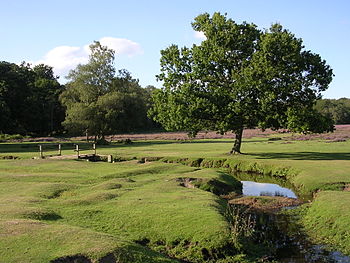
The New Forest fills much of the south-western part of Hampshire, and trespasses too into neighbouring Wiltshire. It includes one of the largest remaining tracts of unenclosed pasture land, heathland and forest in the heavily populated south-east of Great Britain.
The forest was created by William the Conqueror as a royal hunting forest, and it was while hunting here that his son and heir, William Rufus, was slain by an arrow. The name "New Forest" refers to its creation by the Conqueror, for it was new over 900 years ago. The forest is still maintained by a Court of Verderers for the benefit not of hunting princes but of the commoners of the forest.
The forest was, in the face of great controversy, created a National Park in 2005.
There are many villages dotted around the area, and several small towns in the Forest and around its edges.
Prehistory
There are around two hundred and fifty round barrows[1] within its boundaries, and scattered boiling mounds, and it also includes about 150 scheduled ancient monuments.[2] One such barrow in particular may represent the only known inhumation burial of the Early Iron Age and the only known Hallstatt burial in Britain; unfortunately, the acidity of the soil means that bone very rarely survives.[3]
History
The New Forest was created as a royal forest by King William I in about 1079 for the royal hunt, mainly of deer.[4] It was created at the expense of more than 20 hamlets and isolated farmsteads; hence it was 'new' in his time as a single compact area.[5]
According to Florence of Worcester (d. 1118), the forest was known before the Norman Conquest as Ytene, a name of unknown origin though several unprove theories.
The forest was first recorded as "Nova Foresta" in Domesday Book in 1086, where a section devoted to it is interpolated between lands of the king's thegns and the town of Southampton; it is the only forest that the book describes in detail. "Probably no action of the early Norman kings is more notorious than their creation of the New Forest", observes H R Loyn, who adds that the picture of evicted peasants and houses burned is uncritical.[6] Twelfth-century chroniclers alleged that William had created the Forest by evicting the inhabitants of 36 parishes, reducing a flourishing district to a wasteland; however, this account is thought dubious by revisionist historians, as the poor soil in much of the Forest is believed to have been incapable of supporting large-scale agriculture, and significant areas appear to have always been uninhabited.[7][8]
Two of William's sons died in the Forest: Prince Richard in 1081 and King William II (William Rufus) in 1100. Local folklore asserted that this was punishment for the crimes committed by William when he created his New Forest; a 17th-century writer provides exquisite detail:
"In this County [Hantshire] is New-Forest, formerly called Ytene, being about 30 miles in compass; in which said tract William the Conqueror (for the making of the said Forest a harbour for Wild-beasts for his Game) caused 36 Parish Churches, with all the Houses thereto belonging, to be pulled down, and the poor Inhabitants left succourless of house or home. But this wicked act did not long go unpunished, for his Sons felt the smart thereof; Richard being blasted with a pestilent Air; Rufus shot through with an Arrow; and Henry his Grand-child, by Robert his eldest son, as he pursued his Game, was hanged among the boughs, and so dyed. This Forest at present affordeth great variety of Game, where his Majesty oft-times withdraws himself for his divertisement."[9]
The reputed spot of Rufus's death is marked with a stone known as the Rufus Stone.
John White, Bishop of Winchester, said of the forest:
"From God and Saint, King Rufus did Churches take, From Citizens town-court, and mercate place, From Farmer lands: New Forrest for to make, In Beaulew tract, where whiles the King in chase Pursues the hart, just vengeance comes apace, And King pursues. Tirrell him seing not, Unwares him flew with dint of arrow shot."[10]
The common rights were confirmed by statute in 1698. The New Forest became a source of timber for the Royal Navy, and plantations were created in the 18th century for this purpose. In the Great Storm of 1703, about 4000 oak trees were lost.
The naval plantations encroached on the rights of the Commoners, but the Forest gained new protection under an Act of Parliament in 1877. The New Forest Act 1877 confirmed the historic rights of the Commoners and prohibited the enclosure of more than 25 square miles at any time. It also reconstituted the Court of Verderers as representatives of the Commoners (rather than the Crown).
As of 2005, roughly 90% of the New Forest is still owned by the Crown. The Crown lands have been managed by the Forestry Commission since 1923 and most of the Crown lands now fall inside the new National Park.
Felling of broadleaved trees, and their replacement by conifers, began during the First World War to meet the wartime demand for wood. Further encroachments were made during the Second World War. This process is today being reversed in places, with some plantations being returned to heathland or broadleaved woodland. Rhododendron remains a problem.
Further New Forest Acts followed in 1949, 1964 and 1970. The New Forest became a Site of Special Scientific Interest in 1971, and was granted special status as the New Forest Heritage Area in 1985, with additional planning controls added in 1992. The New Forest was proposed as a UNESCO World Heritage Site in June 1999,[11] and it became a National Park in 2005.[12]
-
Death of William Rufus
-
The Rufus Stone Memorial
-
Wartime remains at Ibsley
Common rights
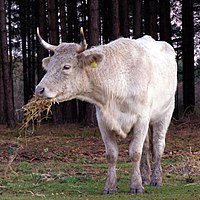
Forest Laws were enacted to preserve the New Forest as a location for royal deer hunting, and interference with the King's deer and its forage was punished. The inhabitants of the area though (commoners) had rights of common: to turn horses and cattle (but only rarely sheep) out into the Forest to graze (common pasture), to gather fuel wood (estovers), to cut peat for fuel (turbary), to dig clay (marl), and to turn out pigs between September and November to eat fallen acorns and beechnuts (pannage or mast). There were also licences granted to gather bracken after 29 September as litter for animals (fern).
Along with grazing, pannage is still an important part of the Forest's ecology. Pigs can eat acorns without a problem, whereas to ponies and cattle large numbers of acorns can be poisonous. Pannage always lasts 60 days but the start date varies according to the weather – and when the acorns fall. The Verderers decide when pannage will start each year. At other times the pigs must be taken in and kept on the owner's land, with the exception that pregnant sows, known as privileged sows, are always allowed out providing they are not a nuisance and return to the Commoner's holding at night (they must be levant and couchant there). This last is an established practice rather than a formal right. The principle of levancy and couchancy applied generally to the right of pasture as it was unstinted [13] but commoners must have backup land, outside the Forest, to accommodate these depastured animals if necessary, for example during the Foot and Mouth epidemic.
Commons rights are attached to particular plots of land (or in the case of turbary, to particular hearths), and different land has different rights – and some of this land is some distance from the Forest itself. Rights to graze ponies and cattle are not for a fixed number of animals, as is often the case on other commons. Instead a marking fee is paid for each animal each year by the owner. The marked animal's tail is trimmed by the local agister (Verderers' official), with each of the four or five Forest agisters using a different trimming pattern. Ponies are branded with the owner's brand mark; cattle may be branded, or nowadays may have the brand mark on an ear tag.
Grazing of commoners' ponies and cattle is an essential part of the management of the Forest, helping to maintain the internationally important heathland, bog, grassland and wood-pasture habitats and their associated wildlife.
Recently this ancient practice has come under pressure as the rising house prices in the area have stopped local commoning families from moving into new homes which have the rights attached. Thus the next generation cannot become commoners until their parents die or move and pass their house, and the attaching rights, to their children.
The Verderers and Commoners' Defence Association have fought back. The Single Payment Scheme has helped some Commoners significantly. Those that put animals out and can claim eligible hectares under the new DEFRA/RPA arrangement can claim up to £850 for each cow per year, and £900 for a pair of ponies. If they also register for the stewardship scheme, they can make more. So with just 10 cattle and 40 ponies, a commoner who qualifies for both these schemes can make over £30,000 a year and more if they put out pigs: well over the national average earnings. They are also being helped to access other EU funds for farming equipment and planning permission is now relaxed for commoners.
Geography
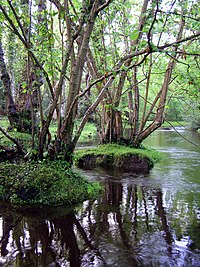
The New Forest is drained to the south by three rivers, Lymington River, Beaulieu River and Avon Water, and to the west by the Latchmore Brook, Dockens Water, Linford Brook and other streams.
The highest point in the New Forest is Pipers Wait, near Nomansland. Its summit is 423 feet above sea level.
The New Forest Site of Special Scientific Interest covers almost 116 square miles, making it the largest contiguous area of unsown vegetation in lowland Britain. It includes roughly:
- 56 square miles of broadleaved woodland
- 46 square miles of heathland and grassland
- 13 square miles of wet heathland
- 32 square miles of tree plantations (inclosures) established since the 18th century, including 31 square miles planted by the Forestry Commission since the 1920s.
Protections
The Forest has been protected ever since its inception under William I, though in latter ages its has taken a less brutal form than was known under the Norman kings, and is under the sympathetic management of its Verderers.
The New Forest National Park was declared in 2006, duplicating or supplanting the work the Verderers have been doing for centuries. The park area covers 219 square miles.[14]
The New Forest Site of Special Scientific Interest covers almost 116 square miles.
The New Forest has also been classed as a National Character Area (No. 131) by Natural England. The NCA covers an area of 73, 767 ha and is bounded by the Dorset Heaths and Dorset Downs to the west, Salisbury Plain and the West Wiltshire Downs to the north and the South Hampshire Lowlands and South Coast Plain to the east.[15]
Wildlife
As well as providing a visually remarkable and historic landscape, the ecological value of the New Forest is enhanced by the relatively large areas of lowland habitats, lost elsewhere, which have survived. There are several kinds of important lowland habitat including valley bogs, wet heaths, dry heaths and deciduous woodland. The area contains a profusion of rare wildlife, including the New Forest cicada Cicadetta montana, the only cicada native to Great Britain. The wet heaths are important for rare plants, such as marsh gentian (Gentiana pneumonanthe) and marsh clubmoss (Lycopodiella inundata). Several species of sundew are found, as well as many unusual insect species, including the Southern damselfly (Coenagrion mercuriale), and the mole cricket (Gryllotalpa gryllotalpa), both rare in Britain. In 2009, 500 adult Southern damselflies were captured and released in the Venn Ottery nature reserve in Devon, which is owned and managed by the Devon Wildlife Trust.[16]
Specialist heathland birds are widespread, including Dartford warbler (Silvia undata), woodlark (Lullula arborea), northern lapwing (Vanellus vanellus), curlew (Numenius arquata), nightjar (Caprimulgus europaeus), hobby (Falco subbuteo), stonechat (Saxicola rubecola), common redstart (Phoenicurus phoenicurus) and tree pipit (Anthus sylvestris). As in much of Britain common snipe (Gallinago gallinago) and meadow pipit (Anthus trivialis) are common as wintering birds, but in the Forest they still also breed in many of the bogs and heaths respectively. Woodland birds include wood warbler (Phylloscopus sibilatrix), stock pigeon (Columba oenas), European honey buzzard (Pernis apivorus) and northern goshawk (Accipiter gentilis). common buzzard (Buteo buteo) is very common and common raven (Corvus corax) is spreading. Birds seen more rarely include red kite (Milvus milvus), wintering great grey shrike (Lanius exubitor) and hen harrier (Circus cyaneus) and migrating ring ouzel (Turdus torquatus) and wheatear (Oenanthe oenanthe).
All three British native species of snake inhabit the Forest. The adder (Vipera berus) is the most common, being found on open heath and grassland. The grass snake (Natrix natrix) prefers the damper environment of the valley mires. The rare smooth snake (Coronella austriaca) occurs on sandy hillsides with Ericaceae|heather and gorse. It was mainly adders which were caught by Brusher Mills (1840–1905), the "New Forest Snake Catcher". He caught many thousands in his lifetime, sending some to London Zoo as food for their animals.[17][18] A pub in Brockenhurst is named The Snakecatcher in his memory. All British snakes are now legally protected, and so the New Forest snakes are no longer caught.
A programme to reintroduce the sand lizard (Lacerta agilis) started in 1989[19] and the great crested newt (Triturus cristatus) already breeds in many locations.
Commoners' cattle, ponies and donkeys roam throughout the open heath and much of the woodland, and it is largely their grazing that maintains the open character of the Forest. They are also frequently seen in the Forest villages where home and shop owners must take care to keep them out of gardens and shops. The New Forest Pony is one of the indigenous horse breeds of the British Isles, and is one of the New Forest's most famous attractions – most of the Forest ponies are of this breed, but there are also some Shetlands and their crossbreeds. Cattle are of various breeds, most commonly Galloways and their cross-breeds, but also various other hardy types such as Highlands, Herefords, Dexters, Kerries and British whites. The pigs used for pannage are now of various breeds, but the New Forest was the original home of the Wessex saddleback, now extinct in Britain.
Numerous deer live in the Forest; they are usually rather shy and tend to stay out of sight when people are around, but are surprisingly bold at night, even when a car drives past. Fallow deer (Dama dama) are the most common, followed by roe deer (Capreolus capreolus) and red deer (Cervus elephas). There are also smaller populations of the introduced sika deer (Cervus nippon) and muntjac (Muntiacus reevesii).
The red squirrel (Sciurus vulgaris) survived in the Forest until the 1970s – longer than almost anywhere else in lowland Britain (though it still occurs on the nearby Isle of Wight). It is now fully replaced in the Forest by the introduced North American grey squirrel (Sciurus carolinensis). The polecat (Mustela putorius) has recolonised the western edge of the Forest in recent years. otter (Lutra lutra) occurs along watercourses, as well as the introduced American mink (Neovison vison).
The New Forest is designated as a Site of Special Scientific Interest (SSSI), an EU Special Area of Conservation (SAC),[20] a Special Protection Area for birds (SPA),[21] and a Ramsar Site;[22] it also has its own Biodiversity Action Plan.
Towns and villages
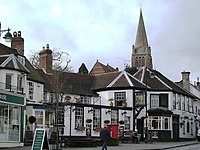
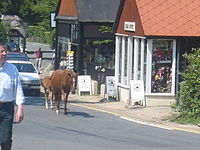
Among the towns and villages lying in or adjacent to the Forest are:
- Lyndhurst
- Abbotswell
- Hythe
- Totton
- Blissford
- Sway
- Burley
- Brockenhurst
- Fordingbridge
- Frogham
- Hyde
- Stuckton
- Ringwood
- Beaulieu
- Bransgore
- Lymington and New Milton.
The forest is bounded to the west by the Hampshire towns of Bournemouth and Christchurch, and to the east by the city of Southampton.
New Forest National Park
Consultations on the possible designation of a National Park in the New Forest were commenced by the Countryside Agency in 1999. Following objections from seven local authorities and others, a Public Inquiry was held from 8 October 2002 to 10 April 2003, and concluded by endorsing the proposal with some detailed changes to the boundary of the area to be designated, and eventually a national park authority for the New Forest was established on 1 April 2005 and assumed its full statutory powers on 1 April 2006. The Forestry Commission retain their powers to manage the Crown land within the Park. The Verderers under the New Forest Acts also retain their responsibilities, and the park authority is expected to co-operate with these bodies, the local authorities, English Nature and other interested parties.
The designated area of the National Park covers 219 square miles[14] and includes many existing SSSIs. It has a population of about 38,000 in south-western Hampshire and part of Wiltshire south-east of Redlynch.
The area covered by the National Park as first proposed was to have been much wider, stretching beyond the forest itself. After a long public enquiry and several court challenges by aghast landowners, the ambitions of the bureaucrats were tamed somewhat; the area of land initially intended to be included but ultimately left out of the park is around 46 square miles in total.
Visitor attractions and places
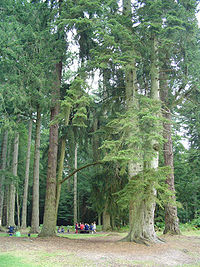
- Buckler's Hard
- Beaulieu
- Blackwater Arboretum
- Exbury Gardens
- New Forest Museum & Visitor Centre Lyndhurst
- New Forest Show
- New Forest Tour
- New Forest Wildlife Park
- New Forest Reptile Centre
- Lymington
Burley and Brockenhurst have well-used facilities for the hire of bicycles to ride on the Forest's cycle paths.
Cultural references
There is an allusion to the foundation of the New Forest in an end-rhyming poem found in the Peterborough Chronicle's entry for 1087, The Rime of King William.
The forest forms a backdrop to numerous books. The Children of the New Forest is a children's novel published in 1847 by Frederick Marryat, set in the time of the Civil War. Charles Kingsley's A New Forest Ballad (1847) mentions several New Forest locations, including Ocknell Plain, Bradley [Bratley] Water, Burley Walk and Lyndhurst churchyard.[23] Edward Rutherfurd's work of historical fiction, The Forest is based in the New Forest in the time period from 1099 to 2000. The forest is also a setting of the Warriors children's novel series. The New Forest and south-east England, around the 12th century, is a prominent setting in Ken Follett's novel The Pillars of the Earth. It is also a prominent setting in Elizabeth George's novel This Body of Death. Oberon, Titania and the other Shakespearean fairies live in a rapidly diminishing Sherwood Forest whittled away by urban development in the fantasy novel A Midsummer's Nightmare by Garry Kilworth. On Midsummer's Eve, a most auspicious day, the fairies embark on the long journey to the New Forest in Hampshire where the fairies' magic will be restored to its former glory.
Pictures

-
Ponies grazing by the Latchmoor Brook
-
New Forest heath and ponies
-
Hatchett Pond near Beaulieu
-
New Forest ponies, September 2007.
-
Conifer trees near Boldrewood.
-
A lone birch at sunset in the New Forest.
-
Pony on frozen heath at sunset.
-
In winter the ponies graze on gorse if the grass is frozen.
Outside links
| ("Wikimedia Commons" has material about New Forest) |
- New Forest Gateway – Film, TV, Picture Resource / Historical Book Publications Online
- New Forest National Park Authority
- The Official New Forest Visitors Website, Visitors Resources and Official Information on visiting and enjoying the forest
- SAC designation including extensive technical description of habitats and species
- UK Clearing House Mechanism for Biodiversity
- Natural England website (SSSI information)
References
- ↑ "Hampshire Treasures". Hants.gov.uk. http://www.hants.gov.uk/hampshiretreasures/vol05/page297.html. Retrieved 3 May 2009.
- ↑ "UNESCO World Heritage". Whc.unesco.org. 21 June 1999. http://whc.unesco.org/en/tentativelists/1318/. Retrieved 3 May 2009.
- ↑ Cunliffe, Barry; Iron Age Communities in Britain 2010, pg 544.
- ↑ "History of the New Forest". New Forest National Park. 2009. http://www.newforestnpa.gov.uk/li_history. Retrieved 16 October 2009.
- ↑ "Old Hampshire Gazetteer (citing Muir, 1981)". port.ac.uk. http://www.envf.port.ac.uk/hantsgaz/hantsgaz/S0004711.HTM.
- ↑ Loyn, Anglo-Saxon England and the Norman Conquest, 2nd ed. 1991:378-82.
- ↑ H. C. Darby. Domesday England, pp. 198–199. Cambridge University Press, 1986. ISBN 0-521-31026-1
- ↑ Young, Charles R. (1979). The Royal Forests of Mediæval England. Philadelphia, PA: University of Pennsylvania Press. pp. 7–8. ISBN 0-8122-7760-0.
- ↑ "Blome, Richard (1673) Britannia: or, A Geographical Description of the Kingdoms of England, Scotland, and Ireland, with the Isles and Terrotories thereto belonging. And for the better perfecting of the said work, there is added an Alphabetical Table of the Names, Titles and Seats of the Nobility and Gentry that each County of England and Wales is, or lately was, enobled with. Illustrated with a Map of each County of England besides several general ones. The like never before published.". Thomas Ryecroft. http://www.envf.port.ac.uk/hantsgaz/hantsgaz/S0008118.HTM.
- ↑ "Camden, William (1610), Britannia. This text is believed to be the translation from Latin made by Philmore Holland about 1610". http://www.geog.port.ac.uk/webmap/hantsmap/hantsmap/camden1/camden1.htm.
- ↑ Entry on the UNESCO Tentative List.
- ↑ History of the New Forest National Park.
- ↑ Review: The Preservation of the New Forest: Report of the New Forest Committee, 1947 H. C. Darby. The Geographical Journal, Vol. 112, No. 1/3. (Jul. - Sep., 1948), pp. 87-91.
- ↑ 14.0 14.1 "New Forest National Park - Learning About - Numbers 30,000 to 120m". New Forest National Park website. New Forest National Park Authority. http://www.newforestnpa.gov.uk/learning-about/figures/numbers-30,000-to-120m. Retrieved 13 January 2013.
- ↑ South East and London National Character Area map at www.naturalengland.org.uk. Accessed on 3 Apr 2013.
- ↑ Wild Devon The Magazine of the Devon Wildlife Trust,page 8 Winter 2009 edition
- ↑ Chris (1 July 1905). "Article about Brusher Mills". Southernlife.org.uk. http://www.southernlife.org.uk/brusher_mills.htm. Retrieved 3 May 2009.
- ↑ "BBC item about Brusher Mills". BBC. 24 July 2002. http://www.bbc.co.uk/southampton/features/newforest/brusher.shtml. Retrieved 3 May 2009.
- ↑ Wildlife and its management in The New Forest, Forestry Commission, January 2004, p. 1, http://www.forestry.gov.uk/pdf/Wildlife.pdf/$FILE/Wildlife.pdf, retrieved 30 August 2011
- ↑ "UK SAC details". Jncc.gov.uk. http://www.jncc.gov.uk/ProtectedSites/SACselection/sac.asp?EUCode=UK0012557. Retrieved 3 May 2009.
- ↑ "UK SPA list". Jncc.gov.uk. 25 September 2008. http://www.jncc.gov.uk/page-1400. Retrieved 3 May 2009.
- ↑ "UK and dependencies Ramsar Site list". Jncc.gov.uk. http://www.jncc.gov.uk/page-1389. Retrieved 3 May 2009.
- ↑ McKay, I. (Ed.), A New Forest Reader: A Companion Guide to the New Forest, its History and Landscape, Hatchet Green Publishing, 2010 (ISBN 978-0-9568372-0-2)
Books
- John Richard de Capel Wise. The New Forest: its history and its scenery (Smith, Elder and Co., 1863)
- C. J. Cornish. The New Forest (New York: MacMillan & Co., 1894).
- Elizabeth Godfrey, E W Haslehust (illustrator). The New Forest (Blackie & Son Ltd., 1912).
- Exum Percival Lewis. Historical inquiries, concerning forests and forest laws: with topographical remarks, upon the ancient and modern state of the New Forest, in the county of Southampton (Printed for T. Payne by J. M'Creery, 1811).











